When knitting, it is important to knit correctly and securely connect the threads so as not to spoil the appearance of the fabric. There are several ways to discreetly connect the ends of the yarn in the middle, along the edges of the product or at the end of knitting.
Why is it necessary to make knots in knitting invisible?
When knitting with needles or a crochet hook, the thread always ends, and as a result, you need to tie a new skein of yarn. Often, beginner knitters put two threads together and tie them with a regular knot. Then, during knitting, the hanging ends need to be woven into the knitting with a hook or a needle, threaded under the knitted loops, pulling the thread. As a result, a thickening will form, which will be noticeable and not very beautiful.
To fix the situation, you can cut the ends of the threads at a close distance. However, after a while, the knot will come undone and a hole will form on the fabric. This type of connection is suitable when knitting threads together at the end or beginning of a row. However, in this case, you will need to cut off most of the yarn. If there is very little of the latter, it is recommended to make a knot.
Knots in knitting should be made invisible so that the fabric looks neat from the front and back sides. At the same time, such a knot will be quite strong.
Features of creating invisible knots:
| Peculiarities | Nuances |
| Change of shade | If the pattern requires a change in shade, it is recommended to use yarn overs to avoid having to join the yarn too often. |
| For ease of wearing | For the convenience of wearing multi-colored clothes, it is advisable to skip at least 4 holes and intertwine the second thread from the back side with the working yarn. |
| Alternating different threads | If the fabric will contain alternation of different threads across a large number of rows, it is necessary to cut the thread or pull it through between the edge and the penultimate element. |
Ways to seamlessly join yarns when knitting
You can connect the thread when knitting with knitting needles unnoticeably by changing the yarn at the beginning of the row, with the subsequent hiding of the ends in the side seam. As a result, knots will not form on the fabric. If there are still a lot of threads left, it is recommended to leave the yarn, starting knitting with a new skein.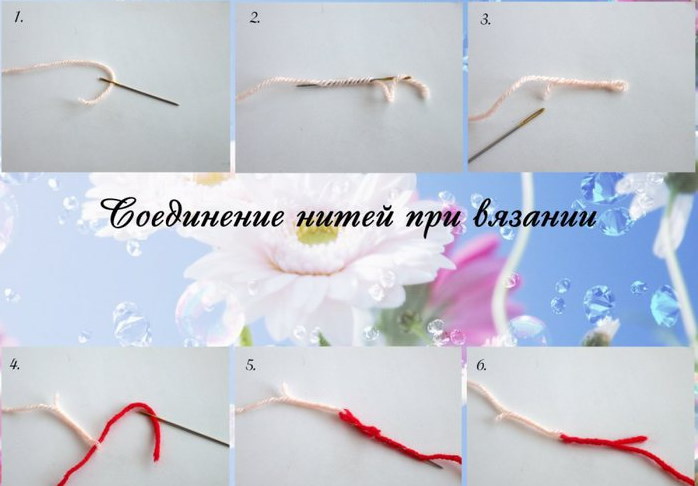
If the row is almost finished and the thread runs out, it is recommended to unravel it, knitting it again with a new skein. However, there are times, for example, when there is not enough yarn or circular knitting, when it is necessary to combine the threads. However, this must be done so that the joining area is invisible and securely fixed. This can be done using different options, providing for different types of yarn.
Weaver's knot
The weaver's or industrial knot is suitable for slippery threads. It allows you to join the yarn unnoticeably, reliably and firmly. This type of knot is in great demand among professional seamstresses in factories, since it does not creep on the line and prevents thread breaks.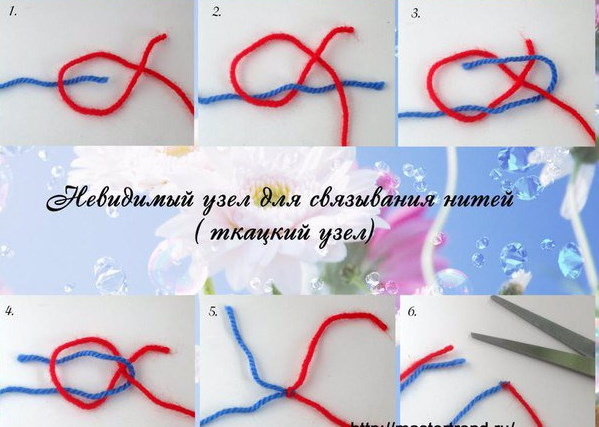
Step by step instructions:
- Make a loop at the end of one yarn.
- Pass the end of the other thread through this loop from below and bring it under the first yarn on the right side. The end should be long.
- The end that was inserted into the loop is inserted into the loop again, but from the other side.
- Pull the shortened edges a little, holding the knot with your fingers. At the same time, check that everything is even and correctly positioned.
- Using a little force, tighten the extended ends of the yarn so that the knot becomes smaller than the diameter of the threads.

Despite the fact that the weaver's knot is very small in size, it will be quite strong. Due to this, you can cut off the ends of the yarn directly near the knot. As a result, you will not need to tuck these ends in later. However, for greater reliability, it is recommended to keep the edges of the yarn.
Knitting in several folds
If you run out of one thread while knitting with thin yarn in several folds, you can do the following:
- Make a loop from the remaining yarn.
- Pass new yarn through the hole, tucking the edges in different directions. The end of the old thread should face the opposite direction from the knitting direction. The end of the new yarn should move relative to the knitting.
- The length of each end of the thread should be at least 10 cm.
Knitting in 2 threads
When knitting with two threads, it is recommended to first change one yarn, then the second. In this case, the free end of the thread should reach about 50 cm.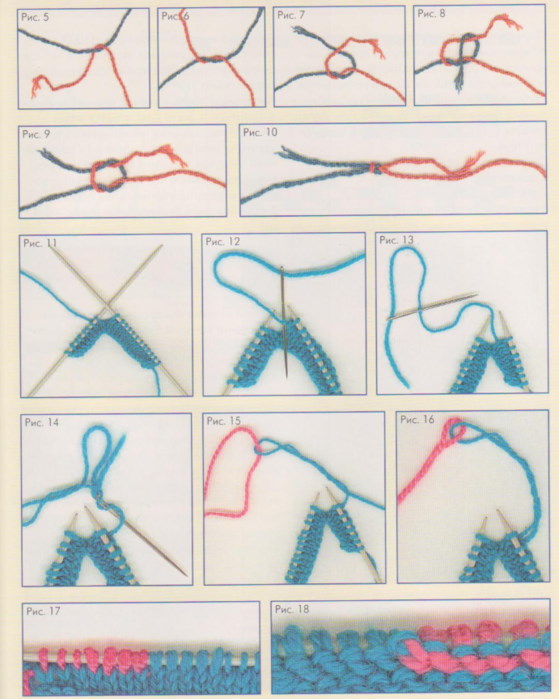
Step by step instructions:
- Initially remove one of the two yarns. Insert one new thread, keeping the end 10 cm long.
- Knit until the edge of the second thread is 10 cm. Insert the second yarn in the same way.
- Hide the ends of the threads with a needle.
Wallow
You can connect the threads when knitting with knitting needles unnoticeably using felting. This method will not create thickenings in the joining area, which are formed during knitting one or more loops in two threads.
The following materials and tools are required for creation:
- 2 yarns of the same shade;
- water;
- scissors.
Step by step instructions:
- Use your fingers to untwist the ends of the threads that need to be joined together a few centimeters in different directions.
- Lightly wet the frayed edges with water.
- Place two strands of yarn overlapping and twist into one thread.
When using thick threads, it is recommended to divide the unfolded part of the yarn in half lengthwise. One half must be torn off or shortened by 4 cm. Thanks to this, after joining the threads, an unsightly thickening will not form.
Stitching a thread with a needle
This option is more suitable for wool yarn consisting of several threads. The method is also suitable for cord material of any composition.
When choosing thick threads, it is advisable to split their edges by 8 cm. Then join the halves of the yarn and tear off the remaining parts without using scissors.
Step by step instructions:
- Thread the end of the thread from the first skein into a blunt-ended needle. Thread the thread from the second skein into the center. A loop should form as a result.
- Thread the thread from the second skein into a needle with a blunt tip. Insert the tool into the hole of the first thread and bring it out to the center of the thread of the second skein.
- Tighten the loops, smoothing out the two sides.
With the help of glue
You can connect threads from different skeins of yarn invisibly using a special glue for knitted fabric. This method is suitable if you use yarn containing cotton or flax for knitting.
Step by step instructions:
- Along 8 cm, divide the edges of the yarn skeins into separate threads, shortening the latter to different lengths. Do not cut the threads, but tear them off.
- Apply glue to the shortened edge of the first mat and stick it on by rolling the thread between your fingers.
- Do the same with the shortened end of the second skein of yarn.
Straight knot
The straight knot for joining threads can be used by beginner knitters, since it is quite strong and easy to perform.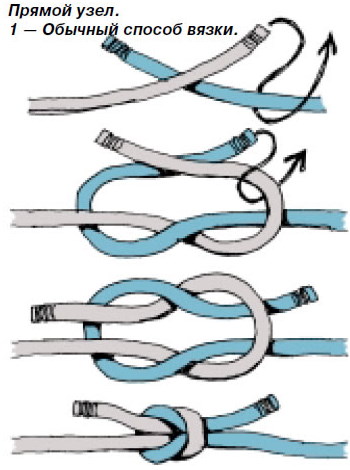
Step by step instructions:
- Place the end of one thread on the end of another material.
- Wrap the top edge around the bottom as if tying a simple knot.
- Place the top edge over the bottom end, wrapping it around the tail from below.
- Pull on the shortened edges, pulling the long tails tightly to secure the knot.
This type of yarn joining is suitable for shaggy threads containing wool or acrylic. As a result, the knot will be strong and small. However, this method of joining threads is not suitable for mercerized cotton, wool with nylon, silk, cotton with viscose yarn. When tightening the threads to secure the knot, the latter will slip and untie.
The best ways to change the thread in the middle of the fabric
When knitting, sometimes you need to join threads from 2 balls of yarn. To prevent knots from spoiling the appearance of the pattern, you can use the knotless method of joining threads.
You can connect the threads invisibly when knitting with knitting needles in the following way:
- Thread the end of the thread through the eye of a needle intended for embroidery. Slightly loosen the yarn twisting tension by twisting the thread a little against the twisting.
- Pass the needle between the threads.
- Pull the end of the yarn to the surface after 3 cm, keeping the loop.
- Insert another yarn into the loop, which needs to be joined with the threads used.
- Tuck the edge into the yarn. As a result, the thread will be joined without forming a knot.
For a neat and durable connection of threads, there is a knotless method that allows you to combine yarn of different colors. For combining, it is recommended to choose threads of the same thickness so that the change in shade looks beautiful and organic. For knitting, you will need straight knitting needles with threads of two shades.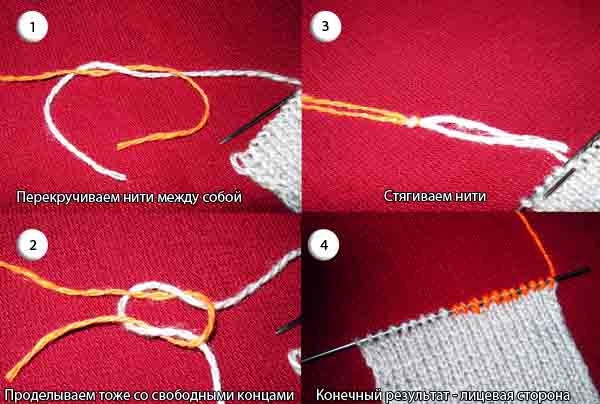
Step by step instructions:
- When moving to another thread in the previous row, do not finish knitting one hole.
- Place the new yarn onto the working thread.
- Knit the last hole, catching two threads. As a result, a double loop should be formed.
- Turn the knitted fabric over so that the multi-colored table loop is first in line.
- Remove this hole like the first edge loop, without knitting.
- Carefully move the old thread aside, knitting the second element with new yarn.
- Form a new row with threads of a different shade.
When working with jacquard or intarsia techniques, it is very convenient to weave the yarn directly at the knitting stage. Otherwise, you will need to sew in a large number of yarn ends.
Step by step instructions:
- Leave 15 cm long thread ends from the old and new skeins of yarn. Do not tie the ends in a knot.
- Continue knitting with a new thread, weaving in the old yarn immediately.
- In a new row, weave in the end of the thread that remains from the new skein.
- When weaving, place the end of the thread in front of and behind the working yarn.
The peculiarity of circular knitting is that it has no seam in which you could later hide the change of yarn. If you change the thread in the center of the circle, you will get an untidy step that will constantly catch the eye.
When knitting in the round, you can easily and seamlessly change yarns if you follow these steps:
- Once the circle is complete, begin a new shade by knitting a full circle.
- Place the right working tool under the right wall of the opening of the previous circle that was knitted during the change of shade. Transfer this element to the left working tool.
- Knit the holes together, moving the marker of the beginning of the circle one element to the left. This procedure is carried out each time after knitting the holes, when a change to a new shade occurs.
- If you do not move the marker, the start of the circle will be located where one circle was formed, but there should have been two.
- The right and left knitting needles should have two circles with a changed shade.
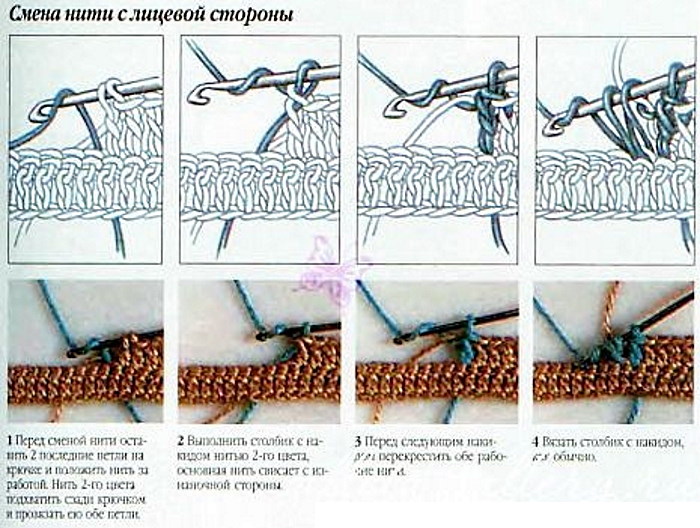 When using this technique, a diagonal of slightly stretched holes should form. This option looks more aesthetically pleasing than steps. When the fabric is washed, the diagonal will be almost invisible.
When using this technique, a diagonal of slightly stretched holes should form. This option looks more aesthetically pleasing than steps. When the fabric is washed, the diagonal will be almost invisible.
What methods are suitable for inconspicuously joining threads along the edges of the fabric?
After finishing the design of woolen products, it is often necessary to combine the connected parts into one piece. This procedure must be carried out unnoticeably so that the front area of the future clothing looks neat and beautiful.
You can connect the threads when knitting without them being noticed using a blanket stitch, which allows you to join different parts of finished fabrics, such as strips, piping or pockets.
This seam is quite easy to create if you follow these instructions:
- From the wrong side, insert the needle into the second hole.
- Insert from above into the first hole and pull from bottom to top through the third element.
- Insert the tool again into the second hole from top to bottom and pull it out through the fourth element from bottom to top.
- Repeat the same manipulations until the end of the row and secure the yarn.
A blanket stitch with a needle makes it possible to make the joining area almost invisible and neat.
The vertical seam is more in demand if it is necessary to sew parts along the edges of the product. This technique is recommended to be performed with the yarn with which the fabric was knitted, or with threads similar in structure and shade. In this case, the material must be very strong.
The mattress seam is a type of invisible vertical seam that can be used to join parts of a single piece of fabric.
Step by step instructions:
- To create an invisible seam, sew the pieces together from the front of the fabric, starting from the bottom end.
- On the right piece, use a needle to catch the yarn between the edge and right holes.
- On the left piece, use a needle to catch the thread between the edge and the last element of the knitted edge.
- Take turns performing similar manipulations, grabbing holes from each part.
- Do not skip rows. If the pieces were knitted with a continuous pattern, you can skip every second row.
- Tighten the yarn every 3 cm so that the stitches are not visible. Do not tighten the stitches tightly, as the seam must remain elastic.
The result should be a perfect seam that is almost invisible.
How to hide the ends of the threads left after knitting?
Sewing the ends of the yarn into the product is considered the most common method of fixing the threads. Thanks to this, the edges of the yarn will not stick out and unravel.
Step by step instructions: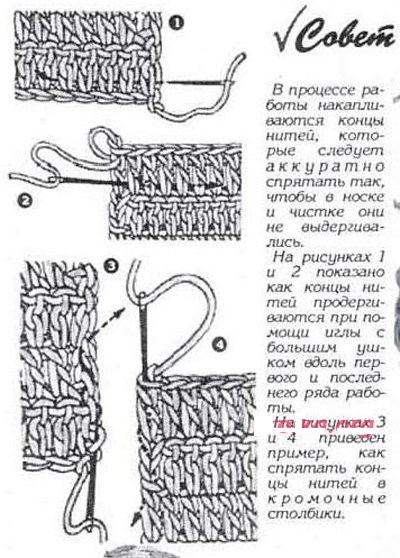
- From the new and old skeins of yarn, leave the ends of the threads 15 cm long, continuing knitting further.
- In new rows, pull the edges of the threads so that the loops in the product remain even.
- To secure, insert the needle with one of the threads into the hole from which the other thread comes out.
- Pull the remaining yarn horizontally through the arcs of the back holes or vertically through the halves of the front elements.
- Insert the needle with the second thread into the hole from which the first thread comes out. Sew in the same way as the first edge of the yarn.
You can hide the ends of the threads that remain after knitting in the following way:
- After knitting the last hole of the securing row, cut the thread, leaving a 7 cm long end.
- Pull the thread through the loop and tighten.
- Thread the yarn into a woolen sewing needle and pull it through the edge holes on the wrong side of the fabric for a length of 4 cm.
There are several options for joining threads when knitting. Sometimes you can introduce new yarn without knots, but this method is not always appropriate, since in such areas of joining you need to knit several loops with a double thread, then tuck in the ends. As a result, thickenings are formed, which in some patterns and yarn cannot remain unnoticeable. In this case, it is better to use a weaver's or straight knot, felting or special glue.
Video about thread connection
How to connect threads without a knot and without thickening:
